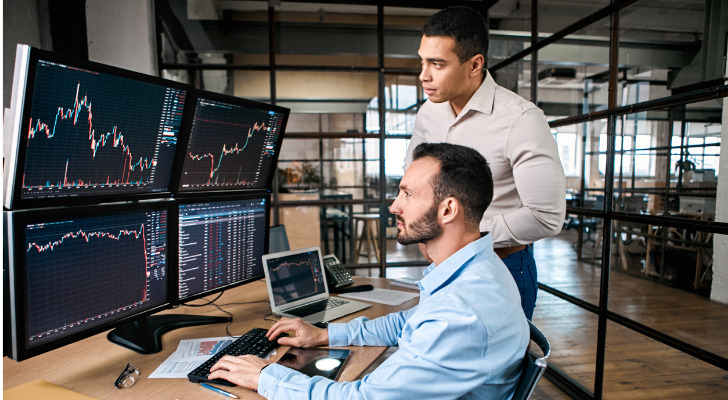One of the most momentous occasions in the business world is when a private firm goes public, starting to offer shares of the company on a stock exchange. This is known as an initial public offering (IPO) and there are various reasons why a company might choose to have one. This page will walk you through how an IPO works and the reasons companies have for going to market.
For help investing, including in companies in the middle of an IPO, consider working with a financial advisor.
IPO Definition
An initial public offering is when a privately owned company holds its first sale of stock to public investors. In other words, IPOs allow the public to purchase shares of companies that have never offered their stock for trading.
Companies of all sizes and ages can hold IPOs. However, they must first undergo a rigorous financial process to demonstrate their viability to public investors.
How Does an IPO Work?
A company that wants an IPO first hires an investment bank or similar financial institution as its underwriter. Next, the underwriter facilitates the IPO by communicating with top-level staff, approaching new investors and instating a realistic stock price. In addition, the underwriter recruits a team of other banks, known as a syndicate, to help sell the shares during the offering.
The underwriter also collaborates with lawyers, accountants and Securities and Exchange Commission (SEC) specialists to generate the company’s financial profile. The profile must pass the SEC’s financial standards by proving that the company is a solid investment for the public. Then, when the company receives authorization from the SEC to go public, it performs the IPO.
Why Do Companies Offer IPOs?

Companies lose part of their self-ownership during an IPO. But, in return, IPOs bring in substantial capital, which allows them to reinvest in the business or repay debts. So, while an IPO isn’t the only way for a business to raise capital, it can be a stronger financial move than borrowing money or approaching individual investors.
In addition, IPOs reward angel investors — and employees who were compensated with stock options — by allowing them to profit from selling their stock. Also, companies usually receive good press and more attention from the public. These benefits create the perception that an IPO is a rite of passage for companies that have enjoyed moderate success but are looking to grow.
Why a Company Might Not IPO
While there are obvious potential upsides to an IPO, there are also plenty of reasons why a company might choose not to do an IPO.
The most obvious is that you lose control of the firm’s direction. When a company is private, the CEO — who is potentially the founder of the firm, in the case of many startups — can guide the company essentially as she wishes, answering only to the private investors the company has gathered. Once the firm goes public, there are many shareholders, and the company’s leadership has to answer to them.
Unfavorable market conditions are another reason to at least delay an IPO. A down market will mean shares are worth less at the IPO, meaning less money for the firm’s current owners.
Finally, going public means more regulation from the government, which can be time-intensive and potentially costly.
IPO Key Terms
IPOs happen quickly and use industry-specific terms. You’ll be able to keep up with the pace by remembering them:
- Common stock refers to the shares a company sells during its IPO. Common stock, unlike preferred stock, gives owners the right to vote on the company’s actions. IPOs confer common stock, not preferred stock.
- Preliminary prospectus is the file defining the company’s business approach and management team. It also includes company financial statements and its latest profits and losses. The preliminary prospectus is also referred to as a red herring because its cover has red letters on one side.
- Issue price is the price per share of common stock sold during the IPO. This price is typically lower than the price to purchase stock after the IPO is finished.
- Price band allows investors to make offers to purchase stock at varying prices. However, investors with higher offers will likely retain the opportunity to buy shares. In addition, individual investors may have to pay more for shares than institutional investors.
- Lot size is the minimum amount of shares you must purchase during an IPO. Investors cannot purchase an amount less than the lot size and can purchase more shares in multiples of the lot size.
How to Invest in an IPO

As an individual investor, you won’t have direct access to IPOs. Instead, you’ll need an account with a brokerage that allows its clients to invest in IPOs. For example, opening an account with TD Ameritrade, E*TRADE, Charles Schwab, or Fidelity can help you access IPOs. Most brokerages also mandate clients to invest a specific amount or maintain a high level of trade activity to be able to participate in IPOs.
Moreover, purchasing shares at a reasonable price during an IPO is challenging because you won’t have the earliest access. Usually, founding investors, family and friends of the company are first in line for shares at an IPO and can nab shares at discounted prices. Afterward, large financial institutions have their pick of shares, leaving little for the average investor to purchase.
However, brokers like SoFi and Robinhood give their clients a chance to buy shares earlier in the IPO. As a result, investors using these firms can get better prices in IPOs. But they’ll need the money required to buy the minimum lot size, and it’s wise to research the company before jumping into its IPO.
Should You Invest in an IPO?
Investing in IPOs is a risky proposition. Companies likeLyft and Pets.com conducted their IPOs amid much fanfare and anticipation — and both companies failed to provide profits to shareholders, with Pets.com collapsing entirely.
On the other hand, Peloton, the exercise company, went public in 2019 at about $25 per share. Stock prices declined until the COVID-19 pandemic began, and by February 2021, its stock had increased to $154.67 per share.
However, as restrictions lifted, gym memberships and other exercise options became available again. Peloton now trades at about $11 per share. Therefore, it’s challenging to predict which IPOs will be profitable and how companies will succeed in the future.
Another element making IPOs risky is the lack of data. Private companies generally don’t have the same amount of financial information as public ones, meaning that using the company’s track record to establish reliability can be impractical.
However, a benefit of investing in an IPO is to diversify your portfolio. Fortunately, you can purchase shares in exchange-traded funds (ETFs) that invest in IPOs. This option spreads the risk among numerous companies, requires less research and gives you exposure to new companies.
The Bottom Line
Companies do IPOs to become publicly traded entities and profit from selling shares of stock. Although they undergo a rigorous process to conduct an IPO, purchasing shares still carries significant risk because formerly private companies don’t have extensive histories of proven success. That said, investors willing to take a deep dive into financial information and market conditions can make informed purchases during an IPO.
Tips for IPO Investing
- A financial advisor can help you make well-founded decisions regarding IPOs. Finding a qualified financial advisor doesn’t have to be hard. SmartAsset’s free tool matches you with up to three financial advisors who serve your area, and you can interview your advisor matches at no cost to decide which one is right for you. If you’re ready to find an advisor who can help you achieve your financial goals, get started now.
- If you want to get involved with up-and-coming companies as early in the process as possible, you may want to invest in a special purpose acquisition company (SPAC). Use this guide for more on this IPO alternative.
Photo credit: ©iStock.com/Andranik Hakobyan, ©iStock.com/Drazen_, ©iStock.com/Viktoriia Hnatiuk
